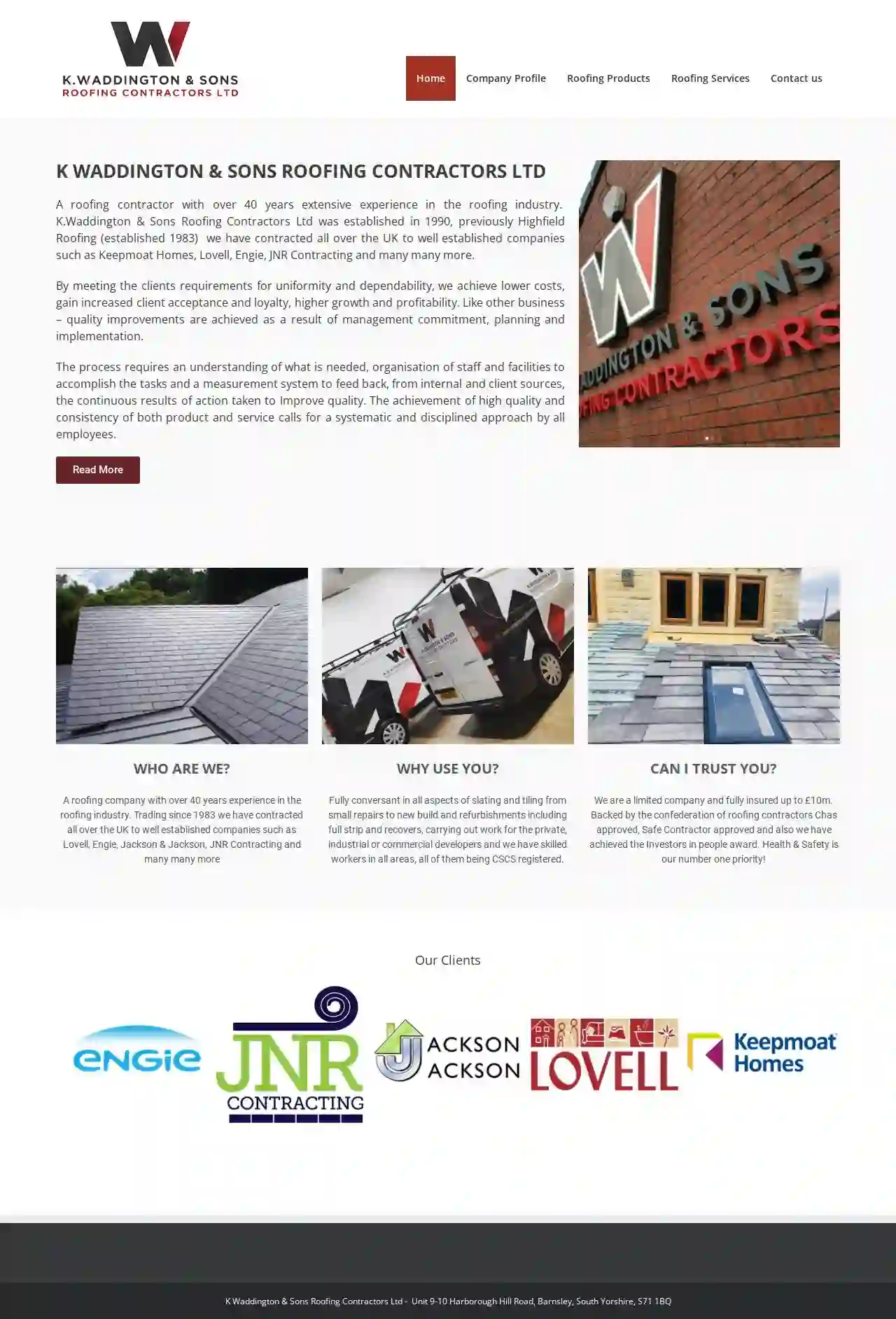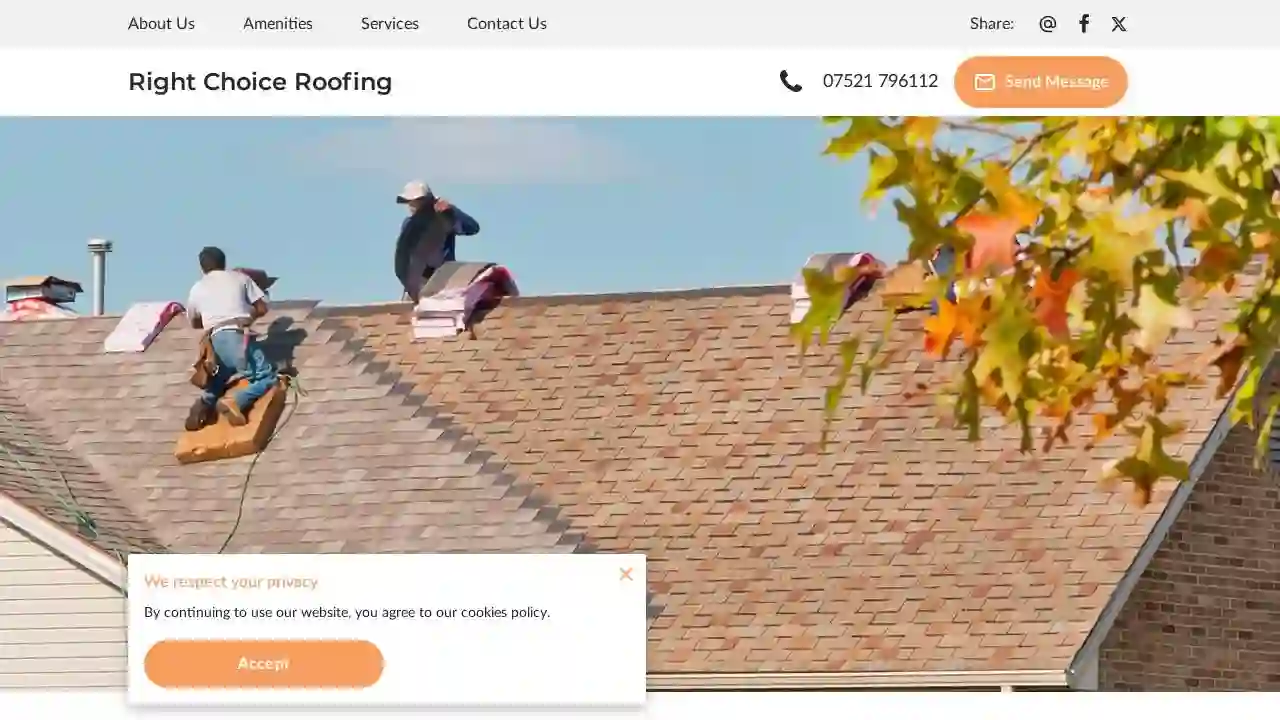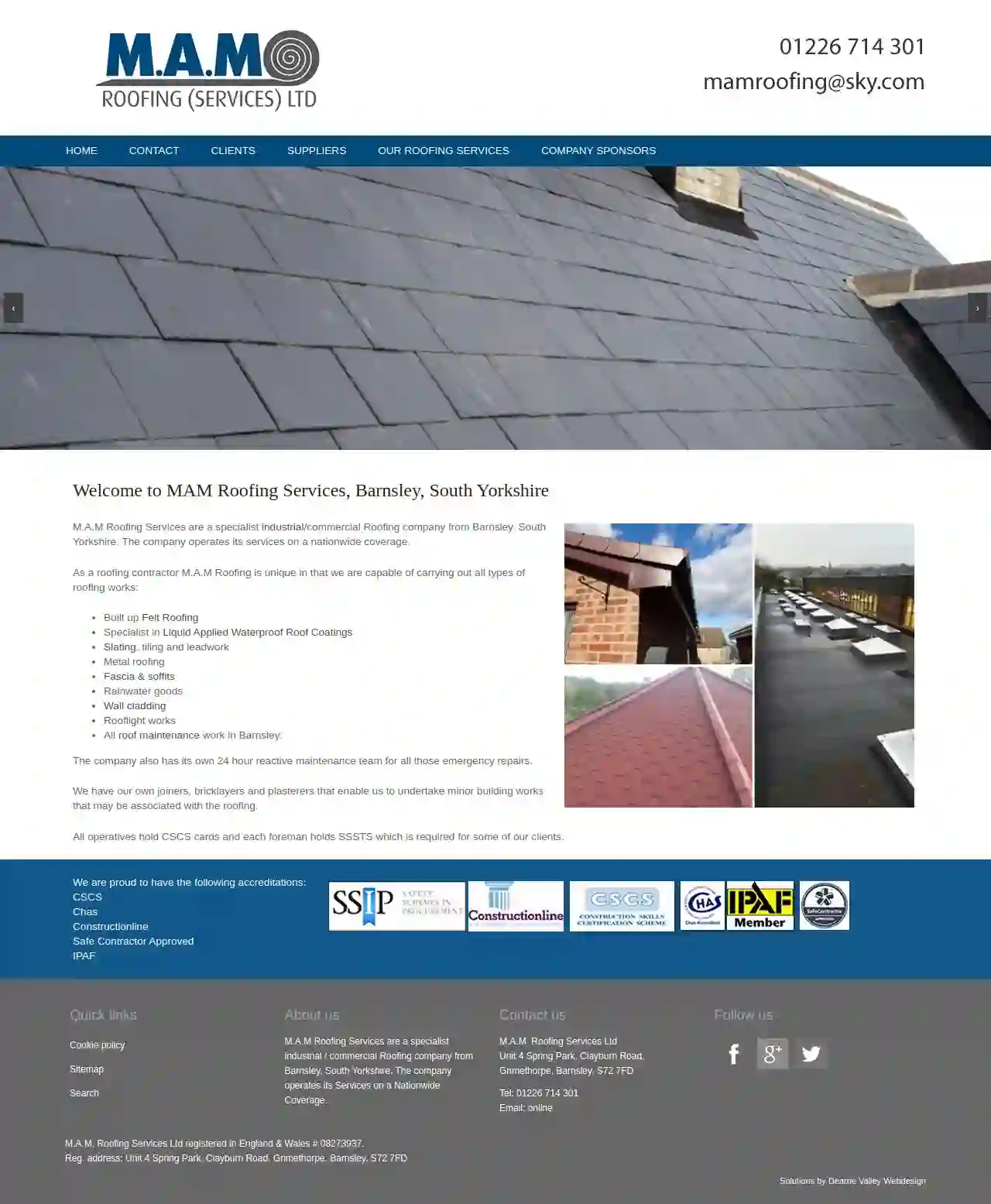Roofing Companies Worsborough
Best Roofing Contractor in Worsborough
Get up to 3 Roofing Service quotes for your project today! Compare profiles, reviews, accreditations, portfolio, etc... and choose the best service.

G S Roofing Supplies
4.545 reviewsUnit 5 Spring Park, Grimethorpe, S72 7FD, GBAt G S Roofing Supplies, based in Barnsley, we pride ourselves on our huge range of roofing supplies and excellent customer service & advice. Our experienced staff are also able measure and quote for products and deliver throughout Barnsley, Rotherham, Pontefract, Wakefield, Doncaster and Sheffield. We provide a comprehensive range of roofing supplies and services throughout the Barnsley & South Yorkshire. As fully qualified and experienced roofing materials suppliers, we are able to provide expert advice. Either visit our friendly Barnsley team today, or send us your requirements for a quote. We also have a dedicated team, who offer a free site estimating service. Our time served roofing specialists, can visit your site, measure, estimate and provide all your required roofing supplies for your job. We supply a comprehensive range of roofing supplies and services to suit both domestic and commercial requirements throughout the county.
- Services
- Why Us?
- Accreditations
- Testimonials
- Gallery
Get Quote
Notts Roofing Ltd
Vernon House, Friar Lane, Nottingham, NG1 6DQ, GBNotts Roofing Ltd is a reputable roofing company based in Nottingham, Derby, and Loughborough. We offer a range of services including re-roofing, roof repairs, fascias, soffits, and guttering, flat roofing, and leadwork. Our team of experts is dedicated to providing high-quality workmanship and excellent customer service. With years of experience in the industry, we have built a reputation for being reliable, efficient, and hardworking. We are proud to be a member of various trade associations and have received numerous accreditations and certifications. Our team is committed to providing a stress-free experience for our customers, from the initial consultation to the completion of the project. We understand the importance of communication and will keep you informed throughout the process. Our goal is to provide a service that exceeds your expectations and leaves you feeling satisfied with the final result.
- Services
- Why Us?
- Accreditations
- Our Team
- Testimonials
- Gallery
Get Quote
hawcroft roofing & damp proofing specialists
3.914 reviewsBarnsley, GBHawcroft Roofing & Damp Proofing Specialists is a family-run business with over 3 generations of experience in the industry. We provide a wide range of services, including roofing repairs and installations, damp proofing, and conversions. Our team of skilled roofing contractors serves domestic and commercial clients throughout Yorkshire, with a 24-hour phone line available for emergency situations. We offer a 20-year insurance-backed guarantee on our damp proofing services and a 10-year guarantee on all our roofing and damp proofing services. Our clients include major commercial clients such as Northern Powergrid, Freedom Infrastructure, Qualter Hall, and Tomlinson's Contractors.
- Services
- Why Us?
- Accreditations
- Gallery
Get Quote
D S M Roofing
4.52 reviews17 Fall Bank Industrial Estate, Dodworth, Barnsley, South Yorkshire, S75 3LS, GBDSM are a dedicated building envelope contractor specialising in complete envelope solutions. Our Latest Projects Clients expect the best and it is our mission not only to meet this but to exceed it. We have a responsive and personable team whose aim is to promote high standards of integrity, honesty, and professionalism at all times. Woodmansterne School Modular Project Architectural Flashings Woodmansterne School was a modular project with modules supplied by Elliott’s. Our package was small but incredibly specialist, our client required an eye-catching entrance and a prism of colour above three further exits. Working closely with our aluminium supplier Fusion Facades, we created a rainscreen solution that took into account tolerance issues associated with modular […] What we offer Envelope Contracting Steel Structures Roofing Solutions Cladding Design
- Services
- Why Us?
- Gallery
Get Quote
Royston Roofing
3.58 reviewsGBAt Royston Roofing, we take pride in providing top-quality roofing services in Barnsley and the surrounding areas. With years of experience and a team of skilled professionals, we are dedicated to delivering exceptional results for all your roofing needs. Whether you require a new roof installation, roof repairs, or various other roofing services, we've got you covered. With over 30 years of experience handed down from father to apprentice son, we strive to ensure our customers get the best quality roofing service possible. Our staff are fully qualified and experienced roofers. As we're a small independent company, we have low overheads, ensuring we can pass that saving on to our customers.
- Services
- Why Us?
- Gallery
Get Quote
K Waddington & Sons Ltd
3.97 reviewsUnit 9-10 Harborough Hill Road, Barnsley, S71 1BQ, GBK.Waddington & Sons Roofing Contractors Ltd is a roofing contractor with over 40 years of experience in the roofing industry. Established in 1990, the company previously operated as Highfield Roofing, founded in 1983. K.Waddington & Sons has contracted throughout the UK for well-known companies like Keepmoat Homes, Lovell, Engie, JNR Contracting, and many others. Their commitment to meeting client requirements for uniformity and dependability results in lower costs, increased client acceptance and loyalty, higher growth, and profitability. Like other successful businesses, quality improvements at K.Waddington & Sons are achieved through management commitment, planning, and implementation. This process involves understanding client needs, organizing staff and facilities to complete tasks, and implementing a measurement system to gather feedback from both internal and client sources on the continuous results of actions taken to improve quality. Achieving high quality and consistency in both product and service requires a systematic and disciplined approach from all employees. We are fully conversant in all aspects of slating and tiling, from small repairs to new builds and refurbishments, including full strip and recovers. We work for private, industrial, and commercial developers and have skilled workers in all areas. All our workers are CSCS registered, and the majority hold NVQ qualifications. Our company is a limited company fully insured up to £10,000,000. We are also backed by the Confederation of Roofing Contractors, Chas approved, NHBC Safemark, and previously achieved the Investors in People award. A copy of our Company Policy for Health & Safety is available for inspection, and our insurance certificates can be provided upon request.
- Services
- Why Us?
- Accreditations
- Gallery
Get Quote
OTM Industrial Roofing and Cladding Ltd
Unit 18B, Metro Trading Centre, Barugh Green Rd, Barugh Green, Barnsley, S75 1JT, GBOTM are commercial and industrial roofing and cladding specialists, covering all of the UK. We install a extensive range of industrial cladding solutions including over cladding, roof light replacements and asbestos removal. We hold appropriate certificates and insurances giving our clients the peace of mind that all our projects will be carried out to a high standard and all health and safety regulations will be adhered to as we have our own health safety consultant. Whether its a building refurbishment or new building we are trusted and reliable and have over 15 years experience. Call us today to see what we can do to improve your buildings and help your business.
- Services
- Why Us?
- Accreditations
- Gallery
Get Quote
Right Choice Roofing
Barnsley, GBBest Roofer in BarnsleyWhether you need a small patching job or a complete re-roofing, our team of dedicated roofers at Right Choice Roofing are here to help. We can easily travel to you wherever you are in Barnsley, and our competitive prices mean you'll be completely satisfied. We are experts in roof tiling, patch work, insulation, V-lux installation and all other roofing jobs, so call us today on +447521796112 for a free quote or fill out the request form to let us know your needs.
- Services
- Why Us?
Get Quote
M A M Roofing Services Ltd
51 reviewsUnit 4 Spring Park, Clayburn Road, Grimethorpe, S72 7FD, GBM.A.M Roofing Services are a specialist industrial/commercial Roofing company from Barnsley, South Yorkshire. The company operates its services on a nationwide coverage. As a roofing contractor M.A.M Roofing is unique in that we are capable of carrying out all types of roofing works: Built up Felt Roofing, Specialist in Liquid Applied Waterproof Roof Coatings, Slating, tiling and leadwork, Metal roofing, Fascia & soffits, Rainwater goods, Wall cladding, Rooflight works and all roof maintenance work in Barnsley. The company also has its own 24 hour reactive maintenance team for all those emergency repairs. We have our own joiners, bricklayers and plasterers that enable us to undertake minor building works that may be associated with the roofing. All operatives hold CSCS cards and each foreman holds SSSTS which is required for some of our clients. We are proud to have the following accreditations: CSCS, Chas, Constructionline, Safe Contractor Approved, IPAF.
- Services
- Why Us?
- Accreditations
- Gallery
Get Quote
M Taylor Roofing
4.515 reviewsBarnsley, GBAt M. Taylor Roofing, we have been providing a broad range of roofing services for over 20 years that are designed to serve the needs of our customers and satisfy their requirements. When roofing, we always use high-quality materials.
- Services
- Why Us?
- Gallery
Get Quote
Over 12,314+ Roofers onboarded
Our roofing contractors operate in Worsborough & surrounding areas!
Roofyng.co.uk has curated and vetted the Best Roofing Contractors arround Worsborough. Find a reliable contractor today.
Frequently Asked Questions About Roofing Companies
- Ventilation: Soffit vents provide intake ventilation, allowing fresh air to enter the attic and regulate temperature and moisture.
- Aesthetics: It creates a finished look to the roof's underside.
- Pest Control: A properly sealed soffit prevents pests like birds and squirrels from nesting in the attic.
- Metal roofs: Reflect sunlight, reducing cooling costs.
- Tile roofs: Offer thermal mass, regulating temperature.
- Cool roofs: White or light-colored roofs with high solar reflectance.
- Green roofs: Vegetated roofs providing insulation and reducing heat absorption.
- Listed Buildings: Buildings with historical or architectural significance.
- Conservation Areas: Areas with special architectural or historical character.
- Changes to Roof Design: If you're making significant alterations to the roof's design, such as adding a dormer window or changing the pitch.
- Choose Reflective Roofing Materials: Opt for light-colored shingles or metal roofing that reflects sunlight and reduces heat absorption.
- Install Proper Attic Insulation: Adequate insulation prevents heat loss in the winter and heat gain in the summer.
- Ensure Adequate Ventilation: Proper attic ventilation allows hot air to escape, reducing cooling costs and extending the lifespan of your roof.
- Consider a Radiant Barrier: In hot climates, a radiant barrier installed in the attic can reflect heat away from the roof, further reducing cooling needs.
What is a soffit, and why is it important for my roof?
What are some energy-efficient roofing options?
Do I need planning permission to replace my roof in the UK?
How can I make my new roof more energy-efficient?
What is a soffit, and why is it important for my roof?
- Ventilation: Soffit vents provide intake ventilation, allowing fresh air to enter the attic and regulate temperature and moisture.
- Aesthetics: It creates a finished look to the roof's underside.
- Pest Control: A properly sealed soffit prevents pests like birds and squirrels from nesting in the attic.
What are some energy-efficient roofing options?
- Metal roofs: Reflect sunlight, reducing cooling costs.
- Tile roofs: Offer thermal mass, regulating temperature.
- Cool roofs: White or light-colored roofs with high solar reflectance.
- Green roofs: Vegetated roofs providing insulation and reducing heat absorption.
Do I need planning permission to replace my roof in the UK?
- Listed Buildings: Buildings with historical or architectural significance.
- Conservation Areas: Areas with special architectural or historical character.
- Changes to Roof Design: If you're making significant alterations to the roof's design, such as adding a dormer window or changing the pitch.
How can I make my new roof more energy-efficient?
- Choose Reflective Roofing Materials: Opt for light-colored shingles or metal roofing that reflects sunlight and reduces heat absorption.
- Install Proper Attic Insulation: Adequate insulation prevents heat loss in the winter and heat gain in the summer.
- Ensure Adequate Ventilation: Proper attic ventilation allows hot air to escape, reducing cooling costs and extending the lifespan of your roof.
- Consider a Radiant Barrier: In hot climates, a radiant barrier installed in the attic can reflect heat away from the roof, further reducing cooling needs.